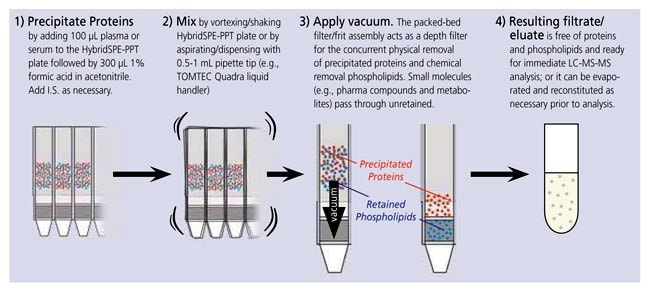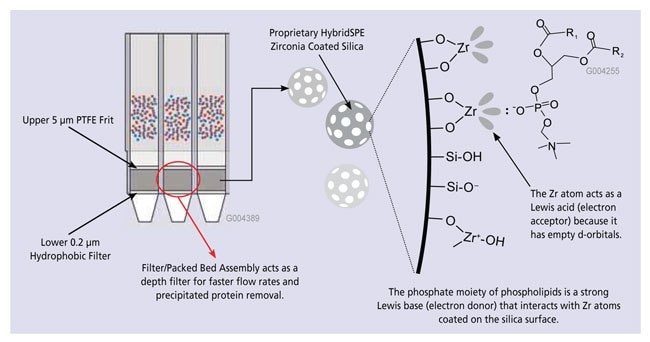HybridSPE-Phospholipid Technology
How Does HybridSPE-PL Work?
HybridSPE-PL technology is a simple and generic sample prep platform, designed for the gross level removal of endogenous protein and phospholipid interferences from biological plasma and serum, prior to LC-MS or LC-MS-MS analysis. Biological plasma or serum is first subjected to protein precipitation in which biological plasma/serum is added to the 96-well plate, followed by acidified acetonitrile (precipitation agent). An upper PTFE frit impedes premature flow of the sample before vacuum application. After a brief mixing/vortexing step to facilitate protein ppt, vacuum is applied to the 96-well plate. The 96-well version contains a series of low porosity hydrophobic filters/frits. The packed bed filter/frit assembly acts as a depth filter, facilitating the concurrent removal of both phospholipids and precipitated proteins during the extraction process. After the protein-precipitated sample passes through the HybridSPE-PL device, the resulting eluent is ready for immediate LC-MS or LC-MS-MS analysis; see Figure 1 for the recommended method.

Figure 1.“In-well” Precipitation Procedure Using HybridSPE-PL 96-well Format

Note: The 1 mL HybridSPE-PL cartridge version does not contain the necessary filters to remove precipitated proteins. As a result, protein precipitation must be conducted outside the cartridge, followed by a centrifugation or filtration step prior to HybridSPE processing. The resulting supernatant/filtrate is then loaded onto HybridSPE-PL cartridge for phospholipid removal.
How Are Phospholipids Removed?
Once the plasma/serum sample is subjected to protein precipitation via the addition of acetonitrile (containing 1% formic acid), it is passed through the HybridSPE-PL packed bed. The packed bed consists of proprietary zirconia coated silica particles. The zirconia sites exhibit Lewis acid (electron acceptor) properties that will interact strongly with Lewis bases (electron donor). Phospholipids structurally consist of a polar head group (zwitterionic phosphonate moiety) and a large hydrophobic tail (two fatty acyl groups that are hydrophobic). The phosphate group inherent with all phospholipids acts as a very strong Lewis base, which will interact strongly with zirconia atoms functionalized on the particle surface (Figure 2). Formic acid is a critical modifier used in the precipitation agent to improve the recovery of many analytes of interest (e.g., acidic compounds). It plays a critical role in preventing analyte retention without affecting phospholipid retention/removal.

Figure 2.HybridSPE-PT 96-well Schematic and Phospholipid Retention Mechanism
Abbreviation Glossary:
- I.S. - Internal Standard
- LLE - Liquid Liquid Extraction
- LLOQ - Lower Limit of Quantitation
- PPT - Precipitation
- SPE - Solid Phase Extraction
TRADEMARKS:
Ascentis, CHIROBIOTIC, HybridSPE – Sigma-Aldrich Biotechnology LP; Fused-Core – Advanced Materials Technologies, Inc.
如要继续阅读,请登录或创建帐户。
暂无帐户?